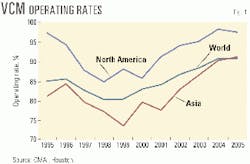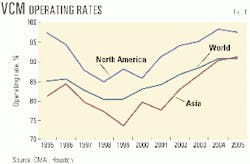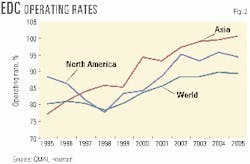The future for the vinyls market remains "bright," despite a miserable short-term outlook, says Rick Smith, executive vice-president and director of the chlor-alkali/vinyls team for Chemical Market Associates Inc. (CMAI), Houston.
The bright outlook is the result of improved demand and a lack of capacity additions between 1999 and 2005.
More capacity required
Almost 20 million tonnes of additional vinyl capacity are required to meet future vinyls demand, assuming global operating rates for polyvinyl chloride (PVC), vinyl chloride monomer (VCM), and ethylene dichloride (EDC) at near 95% capacity.
EDC is a feedstock for the production of VCM, and PVC is the plastic resulting from polymerization of VCM.
Global demand will require an additional 2.6 million tonnes (5.7 billion lb) of PVC capacity between 2003 and 2005. If this capacity is not added, says Smith, PVC operating rates will exceed 100%, and prices and margins will remain at high levels for a protracted period.
To fuel this increased PVC production, 5.5 million tonnes of VCM and 11.6 million tonnes of EDC are required. Figs. 1 and 2 show expected global operating rates for VCM and EDC in Asia and North America.
The current weakness in the vinyls market will probably result in further delays in reinvestment, however.
CMAI expects a 4.3% growth in PVC demand from 1999 to 2005. Comparatively, growth from 1995 to1999 was 5.1%. As demand for PVC improves in 2001 and beyond, prices and margins will improve.




